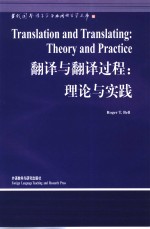

翻译与翻译过程 理论与实践 英文版PDF电子书下载
- 电子书积分:12 积分如何计算积分?
- 作 者:(英)Roger T.Bell著;王克非导读
- 出 版 社:北京:外语教学与研究出版社
- 出版年份:2001
- ISBN:7560025188
- 页数:307 页
Part1:MODEL 1
CHAPTER1 Perspectives on translation 3
1.1 What is translation? 4
1.1.1 Equivalence:semantic and stylistic 6
1.1.2 Rules:description and prescription 10
Preface by Halliday 11
1.1.3 Translation;process and product 12
王宗炎序 12
1.2 What is a translator? 14
1.1.4 Summary 14
Preface by Chomsky 15
1.2.1 Memory,meaning and language 15
1.2.2 The communication process 17
1.2.3 The translation process 20
1.2.4 Summary 21
1.3 What is translation theory? 21
沈家煊序 22
1.3.1 Theories,models and analogies 23
导读 25
1.3.2 Requirements for a theory of translation 26
1.3.3 Methodology;investigating translation 28
1.3.4 Summary 31
1.4 Conclusion 32
Acknowledgments 33
2.1 The translator:knowledge and skills 35
Introduction 35
CHAPTER2 Translating;modelling the Process 35
2.1.1 Ideal bilingual competence 38
2.1.2 Expertise 39
2.1.3 Communicative competence 41
2.1.4 Summary 42
2.2 Translating:the model 43
2.2.1 Components and processes 44
2.2.2 Analysis 45
2.2.3 Synthesis 58
2.2.4 Summary 60
2.3 Using the Process to translate 60
2.3.1 Analvsis:reading the source language text 62
2.3.2 Preparing to translate 68
2.3.3 Synthesis;writing the target language text 71
2.3.4 Summary 75
2.4 Conclusion 75
Part2:MEANING 79
CHAPTER 3 Word-and sentence-meaning 83
3.1 Word-meaning:three approaches 84
3.1.1 Reference theory 84
3.1.2 Componential analysis 87
3.1.3 Meaning Postulates 91
3.1.4 Summary 94
3.2 The thesaurus 95
3.2.1 Lexical and semantic fields 97
3.2.2 Denotation and connotation 98
3.2.3 Semantic differential 100
3.2.4 Summary 102
3.3 Sentence-meaning 103
3.3.1 Words and sentences 103
3.3.2 Utterance,sentence and Proposition 106
3.3.3 Situation,context and universe of discourse 110
3.3.4 Summary 114
3.4 Conclusion 114
CHAPTER4 Logic,grammar and rhetoric 117
4.1 Cognitive meaning,ideational function and TRANSITIVITY 123
4.1.1 Participants and processes 123
4.1.2 Circumstances 127
4.1.3 Logic and the translator 129
4.1.4 Summary 133
4.2 Interactional meaning,interpersonal function and MOOD 134
4.2.1 Communicative exchanges and clause options 137
4.2.2 Chain and choice:phrase options 141
4.2.3 Grammar and the translator 145
4.2.4 Summary 147
4.3 Discoursal meaning,the textual function and the THEME system 148
4.3.1 Organizing information;text structure 149
4.3.2 Thematization 150
4.3.3 Linking clauses:textual cohesion 154
4.3.4 Rhetoric and the translator 156
4.3.4 Summary 158
4.4 Conclusion 158
CHAPTER5 Text and discourse 161
5.1 Standards of textuality 163
5.1.1 Cohesion and coherence 164
5.1.2 Intentionality and acceptability 167
5.1.3 Informativity,relevance and intertextuality 167
5.1.4 Summary 171
5.2 Speech acts and the co-operative principle 172
5.2.1 Components and rules 174
5.2.2 Indirect speech acts 178
5.2.3 The co-operative principle 181
5.2.4 Summary 183
5.3 Discourse parameters 184
5.3.1 Tenor 186
5.3.2 Mode 188
5.3.3 Domain 190
5.3.4 Summary 195
5.4 Conclusion 196
Part3:MEMORY 199
CHAPTER6 Text processing 201
6.1 Text-typologies 202
6.1.1 Formal typologies 203
6.1.2 Functional typologies 203
6.1.3 Text-types,forms and samples 204
6.2 Text processing:knowledge 206
6.1.4 Summary 206
6.2.1 Syntactic knowledge 207
6.2.2 Semantic knowledge 208
6.2.3 Pragmatic knowledge 209
6.2.4 Summary 211
6.3 Text processing:skills 211
6.3.1 Problem-solving and text-processing 214
6.3.2 Synthesis:writing 219
6.3.3 Analysis:reading 222
6.3.4 Summary 226
6.4 Conclusion 226
CHAPTER 7 Information,knowledge and memory 229
7.1 Human information-processing 230
7.1.1 Three stages 231
7.1.2 Three Processes 234
7.1.3 Five demons 235
7.1.4 Summary 239
7.2 Knowledge 240
7.2.1 Conceptual categories and entries 241
7.2.2 Encyclopedic entries 245
7.2.3 Schemas 248
7.2.4 Summary 254
7.3 Memory systems 254
7.3.1 Episodic and conceptual memory 255
7.3.2 Addressing systems 256
7.3.3 Recall from memory 258
7.3.4 Summary 263
7.4 Conclusion 263
CHAPTER 8 Envoi 267
Appendix 269
Bibliography 275
Index 286
文库索引 299
- 《英汉翻译理论的多维阐释及应用剖析》常瑞娟著 2019
- 《催化剂制备过程技术》韩勇责任编辑;(中国)张继光 2019
- 《卓有成效的管理者 中英文双语版》(美)彼得·德鲁克许是祥译;那国毅审校 2019
- 《当代翻译美学的理论诠释与应用解读》宁建庚著 2019
- 《语文教育教学实践探索》陈德收 2018
- 《彼得·布鲁克导演实践研究》邓小玲著 2019
- 《反思性实践》胡红梅, 2019
- 《绿色过程工程与清洁生产技术 张懿院士论文集精选 上》《绿色过程工程与清洁生产技术》编写组编 2019
- 《高含硫气藏开发腐蚀控制技术与实践》唐永帆,张强 2018
- 《化工传递过程导论 第2版》阎建民,刘辉 2020
- 《中风偏瘫 脑萎缩 痴呆 最新治疗原则与方法》孙作东著 2004
- 《水面舰艇编队作战运筹分析》谭安胜著 2009
- 《王蒙文集 新版 35 评点《红楼梦》 上》王蒙著 2020
- 《TED说话的力量 世界优秀演讲者的口才秘诀》(坦桑)阿卡什·P.卡里亚著 2019
- 《燕堂夜话》蒋忠和著 2019
- 《经久》静水边著 2019
- 《魔法销售台词》(美)埃尔默·惠勒著 2019
- 《微表情密码》(波)卡西亚·韦佐夫斯基,(波)帕特里克·韦佐夫斯基著 2019
- 《看书琐记与作文秘诀》鲁迅著 2019
- 《酒国》莫言著 2019
